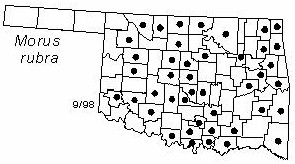Tree to 15 m (50 ft) tall and 30 cm (1 ft) in diameter. Bark light gray to brown, becoming divided into narrow scaly ridges. Twigs thin, light brown, usually glabrous. Buds small, blunt, brown. Sap milky. Leaves alternate, ovate, variable in degree of lobing, sometimes unlobed but often 3-lobed, coarsely serrate, 10-18 cm (4-7 in) long and 6-13 cm (2.4-5.1 in) wide, dark green and rough above, pale green and usually hairy below. Flowers (staminate and pistillate on different trees) small, green, crowded in clusters in early Spring. Fruits small, 1-seeded, numerous, crowded into clusters about 25 mm (1 in) long, red to purple when ripe in late Spring.
Distribution: Native to most of the eastern half of the U. S.
Habitat: Common but seldom abundant in forests, old fields, and roadsides of the eastern 3/4 of Oklahoma.
Comment: The fruits are abundant in most years and are an important wildlife food, especially for squirrels and small birds. The wood is resistant to decay and is used for fence posts. Morus is the old Latin name; rubra refers to the red fruits.
NWI status: FACU
Distribution in Oklahoma: 
BACK
NEXT
RETURN TO INDEX
Last update: 9/14/99
 Go to Oklahoma Biological Survey Home Page
Go to Oklahoma Biological Survey Home Page
 Disclaimer
Disclaimer